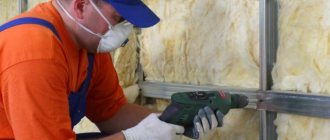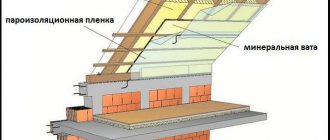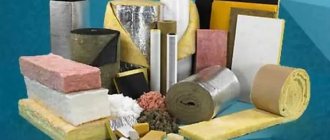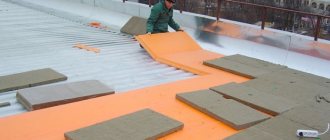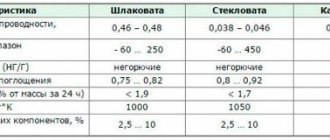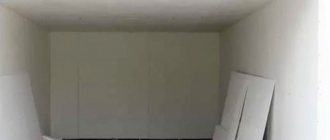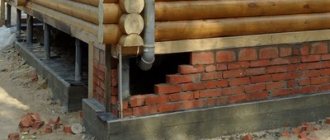Roof insulation with mineral wool
Varieties of mineral wool and options for installing the material on various types of roofing, pros and cons of coatings based on fiber products, rules for selecting components, installation technology.
- Features of work
- Advantages and disadvantages
- Insulation technology
- Selection of mineral wool
- Sloping roof
- Flat roof
Insulating a roof with mineral wool is the creation of a shell for comprehensive protection of the house from cold, overheating, and precipitation. The composition of the thermal insulation coating includes, in addition to the main element, vapor and waterproofing materials, and a screed for protection against mechanical stress. You can learn about the rules for forming an insulating “pie” from this article.
Calculation of insulation thickness and rafter height
The ratio of the thickness of mineral wool and the height of the rafters
When choosing the height of the board or beam for the rafter legs, you must be guided not only by strength calculations, but also take into account the thickness of the insulation. For central Russia, the thickness of the mineral wool layer for a residential building is in the range of 100-150 mm; for the northern regions, the thickness should be increased.
For example, the required height of the rafter leg is 150 mm, and the thickness of the insulation is 180 mm. In this case, you will need to increase the height of the rafters so that it allows you to completely lay mineral wool between the wooden structures and provide a ventilated layer 5 cm thick. If necessary, you can use boards of small cross-section, laid along the rafters. Such boards are called counter-lattice and allow you to competently perform thermal protection of the roof of a house with your own hands from the inside.
You can perform a full thickness calculation without special skills. To do this, you will need to install the Teremok PC application or use the online version.
The program is a fairly simple calculator that can calculate the required insulation thickness or check the already accepted one.
Insulating the attic floor
Of course, the easiest way will be to install thermal insulation during the construction of the building - this will simplify the design and some of the nuances of the work. In most cases, it will not be possible to follow this advice - lack of finances or time may well interfere, so the ceiling remains without insulation. As a rule, this state of affairs persists until the first frost, and the owners have to quickly lay thermal insulation.
Before insulating the attic floor, you need to carry out a number of preparatory work, which is especially important when using bulk thermal insulation materials. There are two insulation technologies - traditional and modern.
The traditional method of floor insulation is implemented as follows:
- The first step is to treat the boards attached to the ceiling with clay or lime mortar - such treatment will ensure the structure is airtight while maintaining normal ventilation;
- When the mixture hardens, you can proceed directly to insulation work - pouring bulk materials into the space between the floor beams onto pre-treated boards.
Today, a more modern method of floor insulation is used much more often:
- First of all, a vapor barrier membrane is laid on the floor and beams with a 20-cm overlap, which will not only protect the insulating material, but will also complement its thermal insulation properties, reducing the amount of heat escaping from the building through the ceiling;
- To ensure a tight seal, the membrane in the overlap areas must be sealed using construction tape;
- The next step is laying the selected insulation (mineral wool, ecowool, expanded clay or one of the bulk materials) using the appropriate technology;
- To ensure that the floor beams do not have cold bridges, it is necessary to ensure that the insulation passes over them;
- Above the insulation, in compliance with the already known rules, another layer of vapor barrier film is laid, which is attached to the beams with counter-battens;
- All that remains is to lay a covering of boards or fairly strong plywood over the finished thermal insulation structure.
Sometimes, instead of insulating the floor from the attic side, thermal insulation is installed inside the building itself. This design is also quite effective in insulation, but requires additional finishing.
Thermal insulation of pitched roof with mineral wool
In order to create a comfortable microclimate in the house and minimize heat loss through the roof, certain preparatory work should be carried out. In addition to the roof itself, it is also necessary to insulate the ceiling of the last floor. After choosing the manufacturer, density, layer thickness and mineral wool model, it is time to calculate the amount of materials. You should not purchase it strictly according to the roof area, especially if it has a complex shape, it has turrets, bay windows, and roof windows. It is better to make a reserve of 5-10% for cutting losses. Otherwise, you can end up in a situation where on Sunday evening there are not enough three mats to finish insulating the roof. If you save the receipt, then the unused material can then be returned to the hardware store.
Before starting work on insulating the roof with mineral wool from the inside, it will be useful to read the instructions for all materials used and apply them in accordance with the manufacturer’s recommendations.
Preparatory work
At the preparation stage, the following operations must be performed:
- carefully inspect the entire rafter system; if parts with traces of mold or rot are found, replace them;
- eliminate all possible roof leaks;
- treat wooden parts with antiseptic and fireproof impregnation;
- check all system components located in the attic: electrical wiring, heating, water supply.
Materials and tools
For work you will need:
- insulation;
- vapor barrier membrane;
- boards or slats 20 mm thick for sheathing;
- Double-sided tape;
- synthetic twine;
- screws and nails;
- antiseptic and fireproof impregnation and means of its application;
- screwdriver;
- hand carpentry tools;
- tape measure, level, ruler;
- a set of thick work clothes and shoes;
- personal protective equipment: gloves, goggles, respirator.
To insulate the roof with mineral wool you will need a screwdriver
Material installation stages
After the necessary preparation has been completed and the materials have been brought into the attic, it is time for the main operations. They are performed in the following sequence:
- To ensure that the vapor barrier does not touch the roof, drive nails into the rafters and stretch synthetic twine between them in a zigzag pattern.
- Roll out the vapor barrier film along the rafters and staple it. The smooth side should face the inside of the attic. Tape the joints of the panels with double-sided adhesive tape.
- Lay insulation mats between the rafters. The mats should fit in with some effort, without any gap. Where it has formed, the cracks must be filled with trimmings.
- Roll out and staple the second layer of vapor barrier along the rafters. Tape the joints of the canvases with an overlap of 10-15 cm.
- Sew up the insulation with slats or boards 20 mm thick.
If you plan to use the room as an insulated attic, use plywood, OSB or gypsum boards instead of slats or boards. They can be used for final finishing.
Vapor barrier materials
The most popular vapor barrier material is a special film that protects wood and insulation from the effects of steam, which turns into condensation as a result of temperature changes. The negative impact of moisture on the elements of the roofing structure need not be mentioned once again - suffice it to say that it significantly reduces the service life of the roof and the effectiveness of the thermal insulation material.
The vapor barrier membrane is attached to the roof or ceiling before thermal insulation materials are laid. In rooms where heating is installed, a vapor barrier should be installed only under the finishing layer. To protect structures that are constantly exposed to temperature contrast, a vapor barrier layer must be placed on both sides. The exception is concrete floors, which do not require such protection.
To create a vapor barrier layer, a film with different characteristics can be used. The simplest option is a film made of non-woven material, but a much more effective option is a foil membrane. The latter option, as its name implies, has a thin layer of foil on one side, which prevents heat from escaping beyond the structure. The roof vapor barrier installed from the inside of the house is connected with special tape, ensuring a tight connection.
Installation of mineral wool between the rafters from the inside of the roof
Before you insulate the roof of a house from the inside with your own hands, you need to understand the options for installing thermal insulation. When laying thermal insulation material from the inside of a roof structure, the simplest option would be to install it in the space between the rafters. True, this method is only relevant if the thickness of the insulating layer does not exceed the width of the rafters, otherwise you will have to do combined thermal insulation of the roof.
Insulating the roof with mineral wool from the inside in this case will look like this:
- The first step is to take a building level and measure the lower level of the rafters, which should be uniform along the entire perimeter of the frame. If there are deviations from the level, it is necessary to align all the rafters so that they run along the same line.
- A waterproofing film must be laid in advance on top of the rafters, which protects the insulation from moisture. If this film was not used when installing the roof, then it will no longer be possible to lay it, so the thermal insulation will be without proper protection.
- Mineral wool is cut into suitable pieces. When installing insulation between the rafter legs, the material is fixed due to the bursting force, so the cut elements should be 2-3 cm wider than the distance between the rafters. When laying the material in two layers, you need to ensure that the joints of one layer do not coincide with the joints of the other.
- The next step is adjusting the vapor barrier. Cut membrane strips are installed above the insulation to protect it from moisture and air. The vapor barrier membrane is installed parallel to the roof slope and fixed with a construction stapler.
- The last stage is covering the insulation, for which plasterboard, plywood or edged boards are usually used. In the future, the cladding will act as a support for the decorative finishing of the attic walls.
When installing insulation on a roof with a slope angle of less than 25 degrees, the following situation may arise: the insulating boards will simply fall out due to a lack of pushing force. To prevent this from happening, the insulation must be additionally reinforced with slats or strong fishing line stretched between the rafters. On slopes with a large slope this problem usually does not arise.
Selection of material for insulation
Today, the choice of thermal insulation materials is so large, and their characteristics are so different, that making the right choice for a particular case can be very difficult.
Most often, developers prefer the following materials as insulation:
- glass wool;
- mineral wool;
- basalt (stone) slabs (there are ready-made sandwich panels with basalt insulation);
- foam plastic (expanded polystyrene);
- polyurethane foam (liquid sprayed insulation).
Recently, Izover, a fiberglass material characterized by a high level of heat and sound insulation, has become especially popular when insulating pitched roofs. Due to the content of air in the structure of this material, its low thermal conductivity is ensured, not exceeding 0.044 W/mK. In addition, this material has incredible durability (at least fifty years), excellent vapor permeability and high fire resistance (flammability class - G1).
When considering other types of roof insulation, you should pay attention to expanded clay. It is also characterized by excellent heat and sound insulation, environmental friendliness and fire safety
Since clay is used for its manufacture, it does not lose its properties under the influence of temperature, does not deform and does not emit any substances harmful to humans, which is possible when using synthetic heat-insulating materials.
Advantages and disadvantages
Choosing mineral wool as thermal insulation for a pitched roof gives the home owner the following advantages:
- excellent insulation;
- long service life;
- resistance to biological factors: mold, microorganisms, pests;
- fire resistance and ability to withstand high heat;
- the breathability of mineral wool helps to establish proper circulation of air masses, improving living conditions in residential premises;
mineral wool has a long service life.
The material also has a number of disadvantages
- when installing slabs or rolls of mineral wool, especially glass wool, harmful dust is generated, this requires the use of personal protective equipment;
- the high hygroscopicity of mineral wool and its loss of thermal insulation qualities when wet requires special attention to the vapor and waterproofing of the insulation system;
- the high specific gravity compared to foam plastic or penoplex leads to the need to strengthen the rafter system.
In general, when insulating residential buildings, the arguments of environmental friendliness and fire safety take precedence over the shortcomings of the material. An important reason to choose mineral wool is its affordable price.
Instructions for insulating a pitched roof
Laying mineral wool
The entire installation process can be divided into several stages of work:
Padding on the rafter legs on the inside of the sheathing boards in increments of 20 to 30 cm - they are needed for attaching the insulation. Mineral wool is laid on the outside of the rafter legs. If insulation is installed for cold regions, it is better to increase the number of layers to two or three. The main working condition is to tightly press the joints of the slabs to the rafters
It is important to ensure that there are no through holes in the mineral wool layer. If after installation you still notice holes, they need to be eliminated using polyurethane foam. When the installation of mineral wool is completed, it is necessary to install a waterproofing membrane
To do this, they simply nail it onto the rafter legs, leaving a slight sag. Installation "in tension" is not advisable. The waterproofing membrane must be positioned correctly. The fact is that such material has a front and a back side. The first is designed to prevent the passage of moisture, but the lower one, on the contrary, allows moisture and vapor to pass upward. The waterproofing material is laid in strips, leaving a slight overlap. It is also necessary to create a gap of 5 cm between the membrane and the mineral wool.
When the waterproofing material is attached in place, we move on to the additional ventilation device. To do this, blocks of wood with a cross-section of 25x50 or 50x50 cm are stuffed onto the rafter legs. They can be used as trimmings of beams. The length can vary from one to two meters. When the bars are in place, it is necessary to fill the sheathing, placing the boards across the rafters. This will create a gap that will facilitate the evaporation of condensation and moisture that will collect on the waterproofing membrane. The roofing material is laid on the sheathing. Do not forget about treating wood with antiseptic solutions. This will help increase the service life of the roofing pie structure. Creating a vapor barrier is an important step in roof insulation. It will prevent water vapor from entering the mineral wool. The vapor barrier film is stretched over the inside of the rafter system. To be able to finish the room, it is necessary to lay sheathing boards on top of the vapor barrier material. For this, slats are used, onto which the internal lining in the form of lining, plasterboard, plywood, etc. will later be attached.
Roof insulation technology with mineral wool
To increase the thermal insulation capabilities of the roof from the inside using mineral wool, it is necessary to select an economically feasible insulation technology by preparing the necessary materials:
- wind protection;
- waterproofing;
- insulation;
- vapor barrier.
To ensure the comfort of the building, as well as to increase the service life, the layers of the roofing cake are arranged in a certain order in the direction from bottom to top:
- ceiling lining on the inside of the room;
- bottom sheathing;
- vapor insulation;
- rafter legs;
- insulation between rafters;
- waterproofing;
- sheathing;
- roofing covering.
Insulating the roof from the inside with mineral wool - choosing mineral wool for roof insulation
Following technologies that provide roof insulation from the inside with mineral wool, manufacturers are constantly updating insulation models, endowing them with unique properties and quality characteristics
Prices for mineral wool
- Foil plates look decent, but create additional problems by disturbing the natural magnetic background.
- Boards coated with film, vapor insulated - the presence of a film does not negate the insulation of the entire roof surface from water vapor by a solid membrane.
- Plates with layers of different densities - the top layer is of increased density, not ventilated under normal conditions in the ventilated facade system, and the main layer is lighter and heat-insulating.
- Mineral wool coated with superdiffusion film provides vapor-permeable protection against blowing mineral wool, but it is more expensive than others.
Mineral wool slabs are more durable. When insulating the roof with your own hands, securing them will not be difficult and will not require special devices.
Insulation of a sloping roof with mineral wool.
When insulating a pitched roof, mineral wool is placed between the rafters. In this case, the size of the layers becomes important. The master chooses the width of the mineral wool blocks to be a couple of centimeters larger than the distance between the beams. Sloping roofs are insulated with sheets with a density of up to 160 kg/cub.m. without fixation. After compression, the panels do not restore their shape and do not hold on their own. To strengthen their position, lathing will be required. Attic roofing is most often insulated by laying the material inside the frame, which reduces work time. Experts advise insulating the pitched roof during the construction of the building, simultaneously with thermal insulation of the walls of the house from the inside. Work should only be carried out in dry weather. In the autumn, the roofing cladding is installed, and then the insulator is laid on the attic side in the prepared place. It is also possible to insulate the roof with mineral wool from the inside in old buildings.
Insulation of the roof from the inside with mineral wool - thermal insulation of a flat roof
To insulate a flat roof from the inside, rigid slabs are used. Rock wool works best, but high-density glass wool can also do the job. Soft mineral wool samples should not be used. When walking on the roof, under the weight of the snow cover, they bend and this can lead to a violation of the integrity of the vapor barrier membrane. To maintain waterproofing, the sheets are covered with a cement-sand screed and increase the load on the floor; as a result, the use of the screed depends on the strength of the structure.
Features of roof insulation from the inside with mineral wool, and the cost of work
Mineral wool is the collective name for three types of insulation that have one common property – a fibrous structure.
Basalt or stone wool is made from rock. It lasts for a very long time, so it is used for capital construction. The most expensive type of mineral wool.
Glass wool made from the same components as regular glass. Cheaper than basalt, but its service life is much shorter. It is used in places where it can be quickly and cheaply replaced.
Slag wool, for the production of which waste from blast furnaces is used. The price and properties are similar to glass wool.
These materials are available in a variety of forms. These can be slabs, rolls, mats, and cylinders.
Insulating a roof with glass wool from the inside is the most effective and affordable way to retain heat in the attic.
In order to insulate the roof from the inside, especially when it comes to a structure made of wooden structures, materials that meet serious requirements should be used. They should be:
- Non-flammable (fire safety class G3 and higher).
- Durable.
- Eco-friendly.
- Rot resistant.
- Possessing not only insulation, but also soundproofing properties.
- Not affected by temperature changes.
- Resistant to damage from insects and rodents.
Mineral wool meets these requirements best of all. To insulate the roof from the inside, mineral wool is used in the form of a roll or mattress. The last option is the most convenient to install.
Prices for mineral wool allow almost every owner of a cottage, bathhouse or garden house to use it for roof insulation.
The only disadvantage of this material is its ability to absorb water, losing up to 40% of its thermal insulation properties. However, insulating the roof from the inside with mineral wool, carried out in strict accordance with technology, helps prevent liquid from entering the insulation.
Well, the quality of roof insulation can be seen using a thermal imager, which can instantly show the places through which heat loss occurs.
What set of tools and consumables will be needed to insulate the roof from the inside?
When carrying out roof insulation yourself, you should prepare everything necessary for the work:
- Minvatu.
- Wooden blocks with a cross section of 40 mm.
- Vapor barrier (for example, any waterproofing film).
- Drill.
- Glue.
- Antiseptic solution for wood.
- Nails or screws.
- Hammer.
- Mineral wool dust respirator.
Materials
Thermal insulation of slopes is carried out if the roof is of the “warm” type. The insulation is laid between the rafters of the frame; this task is performed externally during roofing work. This is due to the fact that securing the plates by holding them above your head is inconvenient and takes a long time. For internal insulation of roof slopes, the following types of mineral wool are used with your own hands:
- Glass wool. Glass wool is a roofing insulation made from glass fibers whose thickness is not more than 15 microns. It is available in the form of rolls, slabs and mats and has high thermal insulation characteristics, resistance to fire, mold and mildew. The plates are quite elastic and durable, which greatly simplifies DIY installation. The price of 1 square meter of glass wool is 140-160 rubles, which is significantly lower than the average price for analogues with the same characteristics. However, this material has a significant drawback - upon contact with the skin, mucous membranes and respiratory tract, it causes severe irritation, so you need to work in a respirator, safety glasses, gloves and overalls that cover the entire body of the master.
Glass wool in roll form - Stone wool. Stone or basalt wool is a fibrous insulation based on a natural mineral, gabbro-basalt. Carbonate rocks, bentonite clay and other composite substances are introduced into the composition of this material. Stone wool retains heat well, does not burn, and is not damaged by mold and fungi. Compared to glass wool slabs, basalt fibers have a less elastic and rigid structure. The price of this material is 1.5-2 times higher than glass wool, however, it is even more popular. This is due to the fact that the use of basalt fiber is completely safe and does not cause harm to health when installing the roof with your own hands and using it.
Stone wool in roll form
Comparison of properties of glass wool and stone wool
Note! Slag wool cannot be used for internal roof insulation. This cheap type of mineral-based insulation is made from waste from the metallurgical industry. But blast furnace slag, from which slag wool is made, during installation releases many tiny tiny particles that are dangerous to human health.
Features of mineral wool
Mineral wool
is very popular as insulation. This material is easy to work with and has a number of advantages, including:
- low thermal conductivity;
- combustion resistance;
- environmental friendliness;
- resistance to aggressive environments;
- high level of heat saving;
- good noise absorption;
- hydrophobicity. This property manifests itself as resistance to wetting; You cannot rely only on the hydrophobic qualities of mineral wool. It is imperative to take measures to protect the under-roof space from moisture. When wet, any insulation will reduce its effectiveness by a couple of times.
- high resistance to deformation;
- ease of installation;
- length of service life.
Unlike foam plastic, careless transportation of the material will not lead to damage. And thanks to the softness of mineral wool, it is easy to install.
Despite similar insulation procedures, mineral wool differs from ecowool, which appeared on the construction market not so long ago, which is an insulator characterized by friability and light weight. Ecowool contains cellulose, antiseptics and boric acid.
Criterias of choice
The main criterion for choosing insulation is its thermal conductivity coefficient. The lower it is, the better the material retains heat. The coefficient value should not go beyond 0.033 – 0.044 W/(m*K).
In addition, you need to take into account such parameters as:
- Density. The load-bearing capacity of the rafter system must allow the required amount of insulation to be placed.
- Vapor permeability, or the ability of a material to remove water vapor without allowing moisture to accumulate on the surface or in the mass of the insulation. The value must be at least 0.7 mg/m*h*Pa.
- Life time. The manufacturer must guarantee the preservation of all working qualities for at least 15 years.
- Environmentally friendly. When making thermal insulation, substances harmful to health or the environment must not be used. The material itself should not emit such substances during operation.
- Manufacturer's reputation. Well-known brands value their reputation and strictly adhere to manufacturing technology and quality control procedures. Insulation is purchased once every few decades, so there is no point in saving money by purchasing products from a little-known manufacturer.
It is also important to consider its purpose when choosing a model.
Leading manufacturers optimize the properties of a particular model for various applications. So, there are special types of mineral wool for floors, walls, flat roofs, and ventilated facades. Basalt wool slabs for pitched roofs are equipped on the sides with 2 cm wide inserts of reduced density and increased elasticity, for better fixation between the rafters.
Insulation of a flat roof
Quite often, flat roofs of houses are used to equip terraces, winter gardens, sports or children's playgrounds. Therefore, such a design must be as reliable as possible and capable of withstanding significant loads, and the thickness of the roof insulation must also be quite significant (also read: “House roof diagram - features”).
Insulation of such a roof is carried out as follows:
- First, a cement screed is installed on the reinforced concrete floor slab, forming a slope. Then a layer of waterproofing is laid;
- after this, a layer of extruded polystyrene foam with a density of at least 35 kg per square meter is laid;
- then, to create filtration, everything is covered with fiberglass, covered with a layer of gravel or pebbles, and finally paving slabs or paving stones are laid.
Foam can also be used to insulate the roof or foam concrete applied to the vapor barrier layer and covered with a foam fiber concrete screed. After this, a welded or membrane coating made of polyvinyl chloride is installed.
In cases where flat roofs are used as an attic, and a soft roof with insulation is planned, a vapor barrier layer and insulation are laid in the attic, and a waterproofing layer is laid under the roofing material. It is also possible to insulate the attic floor with expanded clay. If the use of a flat roof is not expected, then it can be insulated both from the outside and from the inside (for more details: “Insulation of a flat roof and its features”).
Is the most popular one suitable? - Styrofoam
It is worth mentioning that by foam plastic we mean both ordinary, white polystyrene foam (PSB-15) and extruded polystyrene foam, the density of which can reach 35-45 kg per cubic meter.
So, PSB-15 is not used for flat roofs. Although it is much cheaper, it can still be damaged when installing insulation by simply stepping on the sheet. In addition, the foam is made without a quarter. But, for example, penoplex has special grooves at the edges that are fastened together and create one indestructible layer of insulation on the plane.
The ceiling of a cold roof is often insulated with foam plastic in the frame when it is laid between the joists. For the same purposes, more moisture-resistant polystyrene foam is used, which, by the way, has much greater compressive strength.
The issue of using this material for a residential floor under the roof was discussed separately, and this is generally a whole topic.
Thermal insulation materials start with polystyrene foam. But, alas, it does not qualify for the title of best insulation for roofs. That's why they mentioned it at the very beginning. Further - more interesting. [flat_ab id=”34"]
Instructions for insulating a flat roof
All flat roofs are divided into ventilated and non-ventilated. Let's consider both types.
Ventilated flat roof
The structure of a ventilated flat roof
The process of insulating it is similar to the scheme for working with a non-residential attic space. This roof design ensures a minimum distance between the slope and the ceiling, which makes it difficult to move in the under-roof space and reduces the functions of the room to technical ones only.
Mineral wool slabs 20 cm thick are suitable for work. The material is laid on the floor of the attic. Dowels are used as fastening elements. In addition to the mechanical installation method, it is possible to use glue or hot mastic, but the latter method has not gained much popularity. For proper operation of the insulation, it is necessary to place the construction film under it in one layer.
Stages of work
- First, the condition of the entire roofing pie is checked. Damaged elements must be replaced.
- To further insulate the attic, it is possible to lay a layer of mineral wool on top of the existing one.
- Before installing mineral wool slabs, you should clean the surface of the floor that will be insulated. When using reinforced concrete floor slabs, a vapor barrier is not necessary, because concrete does not allow moisture to pass through.
- The beams must also be insulated or covered with insulating materials, or mats must be laid (rolled insulation can be used) between the beams. But before this, it is necessary to install a vapor barrier layer.
- When using foil material, installation is carried out by placing the slabs with the foil down.
- A ventilation gap must be left near the cornice.
Unventilated flat roof
Structure of a non-ventilated flat roof
Concrete slabs or wood are used as the base, depending on the material from which the house is built. The peculiarity of this type of roof is the absence of any gap between the roof and the ceiling. Therefore, it is necessary to install mineral wool directly on the base.
Stages of work
- The vapor barrier film is laid on the base of the roof.
- After this, you can begin laying mineral wool slabs. It is recommended to do this with a checkerboard arrangement of the material so that the joints are not located along the same line. The slabs must be fitted tightly together. The most suitable thickness of the thermal insulation layer is 25 cm.
- Next, roofing felt is laid on top of the mineral wool slabs.
An unventilated flat roof can have various types of thermal insulation:
- Single layer. For this purpose, hard mineral wool slabs are used, which have increased strength. But their thermal insulation qualities are not great.
- Two layer system. For this purpose, elastic plates are suitable for forming the first row, and harder ones are used for the second. In this way, a structure is obtained in which the bottom layer exhibits excellent thermal insulation qualities, and the top layer helps to compensate for the sensitivity of the first row to various mechanical damage. The material used is basalt mineral wool.
- Mixed two-layer system. This option is similar in design to the previous one, but differs in the use of two types of mineral wool slabs. Glass wool is used for the bottom layer, and basalt wool is used for the top layer.
Polyurethane foam for roof insulation
I would like to dwell on one more insulation material, which today is often used for thermal insulation of roofing structures. It is applied by spraying in the form of foam, which polymerizes into a durable mass under the influence of air. A seamless surface is formed on the surface of the processed parts and assemblies, one hundred percent sealed.
It should be noted that the density of polyurethane foam varies over a very wide range: 8-100 kg/m³. So which one is intended for which building structures?
- From 8 to 20 kg/m³ - this is the material that is used for internal insulation and sound insulation. This is an open-cell mass with low mechanical protection that absorbs moisture well.
- 20-25 kg/m³ . Here the situation is this: 50% of the cells are closed, 50% are open. This type of polyurethane foam is used for both external and internal insulation. A mandatory requirement is protection from precipitation.
- Density from 30 to 35 . All pores are closed, which reduces water absorption to a minimum. But such material does not tolerate mechanical loads. Although it is recommended to use it for thermal insulation of foundations for backfilling with soil.
Insulation of the foundation with polyurethane foam Source ppu-perm-master.ru
- 40-45. A material of this density can be used to insulate deep foundation structures.
- 60-70 kg/m³ . Polyurethane foam of this density can be laid under screeds. That is, the density of the material allows it to withstand significant loads. If we talk about the insulation of flat roofs, especially those in use, then this option can be considered ideal.
- 100-110 kg per 1 m³ . This is the most optimal option when the task is to insulate building structures subject to significant mechanical loads.
So, let’s summarize and decide which of the above options is suitable for insulating roof structures. Optimally, it is polyurethane foam with a density of 40 to 60 kg/m³.
Thermal insulation methods
Depending on which structural element of the building is insulated, two methods can be distinguished.
Thermal insulation of the floor
The first option is to insulate the floor. The method is inexpensive and very easy to implement. It consists of laying wool on concrete base slabs or, in the case of a wooden floor, between structural elements. Any type of mineral wool will do, even soft and granular. Installation is simple, there is no need to go around the rafters, as when insulating roof slopes, you can easily fill all the gaps and cracks.
Thermal protection of stingrays
The second option is to insulate the roof slopes. If the room in the attic is not used, then this option is not economically viable. The consumption of materials increases significantly; more time is required due to bypassing the rafters and additional fastening of mineral wool.
Insulation of slopes can be done in two ways: on top of open rafters or between them. With the first option, wooden beams remain visible indoors and have an additional decorative function.
Insulation of a pitched roof
The technology for insulating a pitched roof depends on its structural features, as well as on the purpose of the attic. So, if the attic is non-residential, then the insulation is laid on the ceiling (attic floor), and not between the rafters. If mineral wool is used, then the following roof insulation scheme is recommended, photos of which can be seen on the pages of many specialized publications or websites: walkways are made along the attic joists, and a special membrane is laid on the layer of wool, ensuring steam removal and fiber filtration. After this, the floor is covered with OSB boards, and any floor covering is laid on top of them (useful article: “Types of roofing on pitched roofs”).
How to properly insulate a pitched roof, watch the video:
https://youtube.com/watch?v=C4QOujBaYVQ
If you plan to install a residential attic, then resort to a different insulation technology:
Rafter installation
If the thickness of the recommended thermal insulation layer is thicker than the width of the rafters, then the installation of mineral wool is carried out in two stages. The first layer is laid spaced between the elements of the roof frame, and the second on top of them. This insulation technology requires more material, it is more expensive, but it is guaranteed to protect against heat loss, therefore it is used for equipping residential heated attics. To install mineral wool on rafters with your own hands, you must:
- Using a ruler or tape measure, measure the distance between the rafters. Cut slabs or rolls of insulation so that the width of the material is 2-3 cm greater than this figure.
- If you use mineral wool in the form of rolls, after cutting you need to leave the cut strips for a while in an unfolded state on the floor so that the material rests and straightens.
- Fold the edges of the mineral wool slab towards the center, and then mark it between the rafters and carefully straighten it out.
- Using a construction stapler, secure the vapor barrier membrane sheets to the rafters. The strips are overlapped by 10-15 cm to prevent steam from penetrating through the connecting seams.
- Perpendicular to the rafters, nail slats, the thickness of which is 1-2 cm greater than the thickness of the thermal insulation layer of mineral wool. The pitch between the slats should correspond to the size of the insulation board.
- Mineral wool is placed between the slats, trying to ensure that the knocks between the layers of thermal insulation do not coincide.
- The attic walls are lined with decorative finishing material, using slats as a frame. For lining, clapboard, edged board, plywood or drywall are used, on top of which you can glue wallpaper.
Installation diagram of insulation along rafters
The process of installing mineral wool on rafters
Important! Professional roofers believe that insulating the roof slope over the rafters gives the most effective result. After all, if thermal insulation material is placed only between the rafters, “cold bridges” are formed. This term refers to small streams of cold air that penetrate the interior of the room along the wooden frame elements. The second layer of mineral wool blocks the path to “cold bridges”, optimizing the temperature regime.
How to insulate a roof with mineral wool from the inside
Roof slopes can be equipped using different technologies, but their design always includes a heat-, hydro- and vapor barrier layer, as well as a counter-lattice that creates a ventilation gap and is used for additional fastening of materials.
The roof installation technology involves the following steps:
- Waterproofing is laid on the assembled and installed rafter system. Most often, high-density polyethylene is used as a waterproofing material, which can protect the roof from both moisture and gusty winds. The roof waterproofing is laid from the inside of the house with an overlap of about 20 cm and attached to the rafters with a construction stapler.
- A counter rail is installed above the film along each rafter. This element forms a small gap between the film and the roofing, due to which the structure is constantly ventilated.
- To lay a soft roof, sheets of moisture-resistant plywood are attached above the counter-lattice. Before insulating a metal roof, or a roof made of other solid roofing materials, you will need to create a regular sheathing with a well-calculated distance between its elements.
- After the sheathing is assembled, you can begin installing the roofing.
